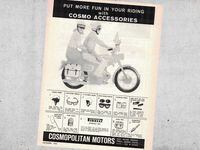Suzuki's X-6 Hustler
In its third year of production, the Suzuki Hustler made it stateside after time in both Europe and Japan. News of the model introduction had swamped dealers with requests from potential buyer's who wanted what they could not get.
With an MSRP below $700, the X-6 looked like a good deal. It had an all-aluminum engine that test engineers say virtually eliminated failures. With piston and cylinder walls that expanded at the same rate, the machine was claimed to be very reliable.
Oil injected directly to all friction bearings as it passes through the crank. From there, the oil traveled through the rod journals and sprayed directly onto the cylinder walls.
With a GP-inspired tubular frame and eight-inch brakes, the Hustler had the potential to turn and stop quite well. Suzuki’s Jack McCormack said that the bike with its race-bred frame was “one of the best handling production motorcycles in the world.”
Turkey Run!
A new style of cross-country motorcycle racing started right after WWII. It was called a "Turkey Run." Competitive motorcycles had to be light, handle well, and have adequate power. In this story, author Richard Renstrom told the tale of how they did a Turkey Run at the Owyhee Motorcycle Club in Boise, ID. With severe elevation changes, Boise was a tough place to ride in the winter. You might have experienced light snow on the desert floor with drifts of six to eight feet within 10 miles as you go vertical.
The course was made up mostly of grass and sagebrush that gave way to forests of pine and spruce. In this same time, the course undulated up and down quite severely. At 1pm the 25 riders raced to their machines and tackled the hills in search of the first checkpoint. They did things a little different in Boise. The checkpoints were two stakes that jutted out of the ground about 12 inches apart from each other with eyelets screwed into the top of them which became a sighting tool. The target sighted would be the next checkpoint. At each checkpoint, there was a paper ribbon to be collected.
Twenty checkpoints later, the first guy to return to the clubhouse was deemed the winner. Routes were totally up to the rider and oftentimes there were several paths travelled. Some travelled through snow-filled valleys and streams while others chose the ridge lines. The Boise Turkey Run took about three hours to complete. And the winner went home with a turkey.










/cloudfront-us-east-1.images.arcpublishing.com/octane/BP2VKGISQGCMWHNZXKCXPB5APA.jpg)







/cloudfront-us-east-1.images.arcpublishing.com/octane/QSTCM6AVEZA5JJBUXNIQ3DSOF4.jpg)
/cloudfront-us-east-1.images.arcpublishing.com/octane/U4I7G625B5DMLF2DVIJDFZVV6M.jpg)
/cloudfront-us-east-1.images.arcpublishing.com/octane/B6XD6LS6IVCQPIU6HXDJSM3FHY.jpg)
/cloudfront-us-east-1.images.arcpublishing.com/octane/ICL63FEDDRDTTMINYICCEYGMDA.jpg)
/cloudfront-us-east-1.images.arcpublishing.com/octane/FCGZHQXRBZFLBAPC5SDIQLVF4I.jpg)
/cloudfront-us-east-1.images.arcpublishing.com/octane/WNOB6LDOIFFHJKPSVIWDYUGOPM.jpg)

/cloudfront-us-east-1.images.arcpublishing.com/octane/X33NU3E525ECRHXLNUJN2FTRKI.jpg)
/cloudfront-us-east-1.images.arcpublishing.com/octane/6KKT5NNL2JAVBOXMZYS5ZO76YA.jpg)
/cloudfront-us-east-1.images.arcpublishing.com/octane/J5RKG5O455GMPGQRF2OG6LRT7A.jpg)
/cloudfront-us-east-1.images.arcpublishing.com/octane/GX2CIZKQVRH2TATDM26KFG2DAE.jpg)
/cloudfront-us-east-1.images.arcpublishing.com/octane/ZWIDYSAKQZHD5BHREMQILXJCGM.jpg)
/cloudfront-us-east-1.images.arcpublishing.com/octane/CYUHJZCTSJCH3MRAQEIKXK7SCQ.jpg)
/cloudfront-us-east-1.images.arcpublishing.com/octane/LKOFINY56FCXJCANJ5M7ZDQUBY.jpg)
/cloudfront-us-east-1.images.arcpublishing.com/octane/4NBPDACMWJH63JQYJVK3QRBDZI.jpg)
/cloudfront-us-east-1.images.arcpublishing.com/octane/KKHQHRR3FJGX7H2IPU6RALMWG4.jpg)

/cloudfront-us-east-1.images.arcpublishing.com/octane/5IOFS5JAE5FOXMNA23ZRAVVYUU.jpg)
/cloudfront-us-east-1.images.arcpublishing.com/octane/CGXQ3O2VVJF7PGTYR3QICTLDLM.jpg)

/cloudfront-us-east-1.images.arcpublishing.com/octane/OQVCJOABCFC5NBEF2KIGRCV3XA.jpg)
/cloudfront-us-east-1.images.arcpublishing.com/octane/OPVQ7R4EFNCLRDPSQT4FBZCS2A.jpg)
/cloudfront-us-east-1.images.arcpublishing.com/octane/YBPFZBTAS5FJJBKOWC57QGEFDM.jpg)
/cloudfront-us-east-1.images.arcpublishing.com/octane/W5DVCJVUQVHZTN2DNYLI2UYW5U.jpg)